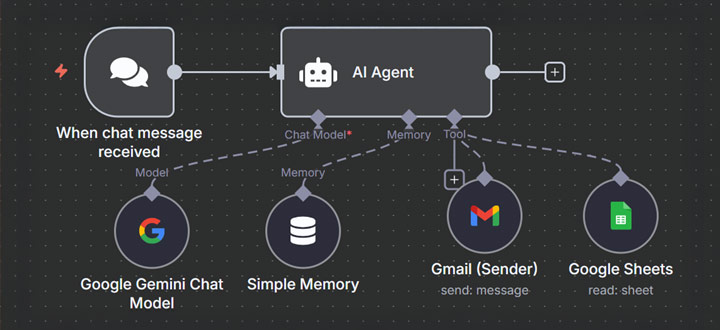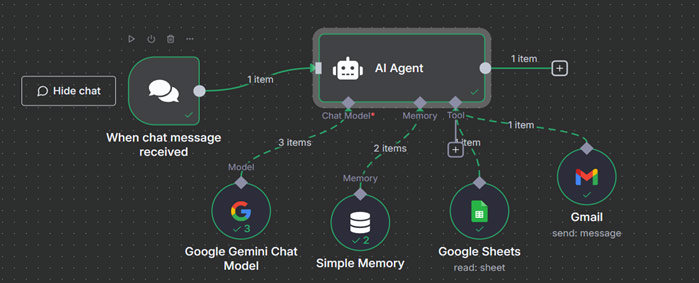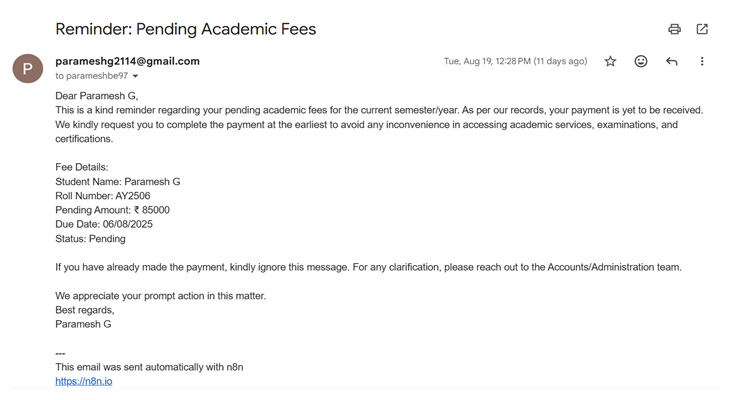AI Agents in Action: Build Smart Workflows with n8n and Open-Source Tools

Introduction
Artificial Intelligence (AI) is progressing quickly beyond predictive models and chatbots. AI agents that can see, think, act, and learn on their own are the way of the future. Agents differ from typical AI models in that they act and interface with real-world systems in addition to offering answers.
The workflow automation platform n8n, which enables you to create intelligent pipelines visually without the need for complex coding, is a potent open-source tool for producing these agents.
What Exactly Is an AI Agent?
An artificial intelligence (AI) agent is a system that uses existing tools to develop workflows and carry out activities on its own. Consider an AI agent as a proactive virtual assistant. In contrast to conventional AI models, which only provide replies, agents are made to:
AI Agents operate in a continuous loop
Through this cycle, agents can develop from reactive bots into self-governing systems that manage activities in the actual world with little assistance from humans. It would be a chatbot for customer service that can autonomously book tickets, Fees Reminder Agent, check order progress, and escalate issues in addition to providing answers to frequently asked questions.
Use Cases in Various Industries: Where AI Agents Succeed
AI agents are already causing a stir in a variety of industries:
| Sector | Use Case Examples |
|---|---|
| Education | Fee reminders, assignment trackers, student helpdesks |
| Healthcare | Appointment scheduling, report summarization |
| Business | Market research, competitor monitoring, support bots |
| Personal Productivity | Task managers, email summarizers, digital planners |
Why n8n for AI Agents?
Core Features:
It’s not just n8n, either. Other fully open-source resources that are worth looking into are:
Purpose of n8n Tools:
Single AI Agent vs Multi-Agent Workflow:
| Aspect | Single AI Agent | Multi-Agent Workflow |
|---|---|---|
| Structure | The task is managed by a single agent from start to finish. | Numerous agents, each with a distinct function. |
| Ideal | Simple, focused tasks (e.g., Fee Reminder System) | Complex, collaborative tasks (e.g., Student Helpdesk) |
| Restrictions | May find it difficult to complete lengthy or multi-step tasks. | Coordination is necessary, but it can scale to more complex issues. |
Build a Fees Reminder Agent:
Workflow Breakdown:
1. Trigger the Workflow
- Method: Scheduled (e.g., every morning) or via a webhook (manual or event-based trigger).
- Tool: n8n or any automation platform.
- Purpose: Kickstart the agent’s daily routine.
2. Generate Message with Gemini
- Prompt: “Write a polite reminder to [Student Name] about their pending fees due on [Due Date]. Include urgency and contact info.”
- Model: Gemini (via API or plugin).
- Output: Personalized, human-like message.
- Purpose: Planning — crafting the communication.

Workflow Architecture
3. Fetch Student Data from Google Sheets
- Action: Connect to a Google Sheet containing student records.
- Fields: Name, Email/Phone, Fee Status, Due Date.
- Tool Integration: Google Sheets node in n8n or via API.
- Why: This is the agent’s perception phase — gathering input data.
4. Filter Students with Pending Fees
- Logic: Identify rows where Fee Status = Pending or Due Date < Today.
- Tool: Built-in filtering in n8n or custom JavaScript function.
- Purpose: Reasoning — deciding who needs a reminder.
5. Dispatch Message via Email/WhatsApp
- Channels:
- Email: Gmail integration
- WhatsApp: Twilio or WhatsApp Business API
- Action: Send the generated message to each student.
- Purpose: Action — executing the task.
6. Log Status Back to Google Sheets
- Update: Mark each student row with “Reminder Sent” and timestamp.
- Tool: Google Sheets API or n8n update node.
- Purpose: Learning — tracking outcomes for future improvements.
Implementation Reference

Results from the Fees Reminder Agent:
Once the workflow was set up in n8n, the AI Agent automatically checked the Google Sheet for pending fees, generated a polite reminder email, and sent it directly to the student’s inbox via Gmail.
Here’s a quick look at the workflow architecture:
- Google Gemini Chat Model → To draft personalized reminders
- Simple Memory → To keep track of past interactions
- Google Sheets → To read student fee data
- Gmail → To send automated reminder emails
It’s not just n8n, either. Other fully open-source resources that are worth looking into are:
And here’s the actual email generated by the AI Agent

Conclusion:
AI agents are here and useful; they are no longer merely theoretical concepts or research projects. They are already demonstrating their worth in a variety of ways, including as automating business processes, creating virtual helpdesks, and reminding educators of fees.
The best part? To get started, you don’t require costly corporate systems or APIs. Anyone may start building their own intelligent agents right now with open-source tools like n8n, Flowise, CrewAI, and Node-RED, whether they are professionals, educators, or students.
The Fees Reminder System we built is just one example of how an AI agent may save time, lessen human labour, and add consistency to daily duties is the Fees Reminder System that we developed. Additionally, the opportunities expand from productivity to customer support, from healthcare to research, when several agents begin collaborating in a multi-agent workflow.
You don’t need permission to innovate. You just need the right agent.
The future isn’t waiting. It’s already working — one smart workflow at a time.



